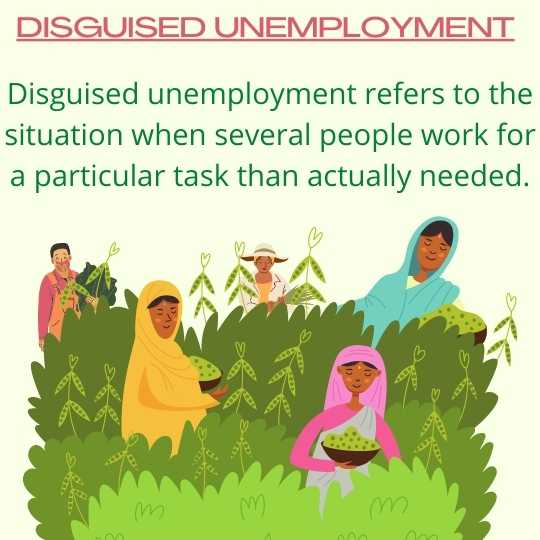Introduction
In simple, unemployment refers to the situation where people (human resources) are not engaged in productive activity. But in fact, it is not only limited to it. Let’s discuss it briefly. Generally, Unemployment is broadly categorized into two different types; Voluntary unemployment and Involuntary Unemployment. They are described below;
Voluntary Unemployment
Voluntary Unemployment refers to the situation in which people don’t want to work at the prevailing wage rate in spite of the availability of work. They may not work due to laziness or not have interest in any gainful work. Voluntary Unemployment does not included in the aggregate estimation. In other words, economists do not consider voluntary unemployment as unemployment. They only consider involuntary unemployment in the aggregate estimation which discusses below.
Involuntary Unemployment
Involuntary unemployment refers to the situation in which people are willing to work at the prevailing wages rate but they cannot find the work. Economists consider only involuntary unemployment as unemployment and included it in the aggregate estimation or in the labor force.
Different Types of Unemployment
Generally, unemployment is categorized into three types. They are Frictional Unemployment, Structural unemployment, and Cyclical Unemployment. But there are also some other types of unemployment.

1. Frictional Unemployment
Frictional Unemployment refers to the situation when the existing workers change jobs and during searching for new jobs, they have to live jobless for some time. It is temporary in nature. Hence, the presence of frictional unemployment should not consider a weakness of the economy. They are not able to get jobs immediately due to a lack of market information about the availability of jobs and lack of perfect mobility on the part of workers. There are many reasons for leaving existing jobs such as getting new opportunities and a good environment.
2. Structural Unemployment
Structural Unemployment refers to the situation in which people have no work due to changes in the fundamental structure of industries or changes in technology. The distinguishing feature of structural unemployment is that the unemployed workers lack the skills required by the expanding industries.
Let’s take an example to understand structural unemployment clearly when banking technology changed to computerization. Many bankers get unemployed due to changes in technology. It is temporary in nature. People again get a job after getting training or acquiring new skills required for the job available. It is much longer than frictional unemployment because unemployed people take training or acquired skills required for jobs available take more time. But in frictional unemployment they don’t have to take training, they have only to search for the job available.
3. Cyclical Unemployment
Cyclical unemployment is the form of unemployment that arise during periods of recession and depression. Recession and depression are one phase of the business cycle. If we have to define cyclical unemployment, we can define it as the form of unemployment that arises due to changes in the component of the business cycle (Recession and Depression). This types of unemployment arise when the entire production(output) did not absorb or when there is over-production. In such a case, to reduce the production factor cost, people get unemployed.
 Sources
Sources Other types of unemployment
Above are the major types of unemployment but besides it, there are also other types of unemployment which explained below in short;
4. Disguised Unemployment
Disguised unemployment refers to the situation when several people work for a particular task than actually needed. People engaged in the work even if their marginal productivity is zero or tends to zero. This type of unemployment mostly found in developing countries in agricultural sectors. For example, consider 1 member is enough to cultivate one acre of land but his two sons also work in the same field and share the task. Technically, all three are employed but in fact, they are unemployed. This type of unemployment known as disguised unemployment. If they (two sons) do not work in the field, there is no effect on productivity. Thus, the marginal productivity is zero in the case of disguised unemployment.

5. Seasonal Unemployment
Seasonal unemployment refers to the situation in which people do not have any work at a certain season of the year. For instance, agriculture in underdeveloped countries is a seasonal occupation where farmers have no work during the offseason. Especially summer season considers an off-season for farmers.
6. Underemployment
Underemployment refers to the situation in which people don’t have work according to their level of qualification and experience they have. They work at a lower level and earn lower than they deserve. Let’s take an example, suppose an MBA graduate work in a shop as a clerk. MBA graduated to work as an accountant or manager but he worked as a clerk for survival.
7. Open Unemployment
Structural Unemployment refers to the situation in which people have no work to do. They are willing to work at prevailing wages but they are unable to find a job.
8. Educated Unemployment
Educated Unemployment refers to the situation in which educated people are unable to find a job to do or do an inferior job (work at a lower level and earn lower than they deserve) for survival.
9. Hardcore (or Residual) Unemployment
Hardcore (or Residual) Unemployment refers to the situation in which people who are physically disable do not find a job. Generally, this type of unemployment created due to the unwillingness of the organization to give them work. Because the organization gets lower productivity in comparison to the employee who is physically fit.
d[su_accordion][su_spoiler title=”Reference sources” open=”no” style=”default” icon=”plus” anchor=”” anchor_in_url=”no” class=””]Asmita Publication, Buddha Publication, https://www.statista.com/ [/su_spoiler] [/su_accordion]

